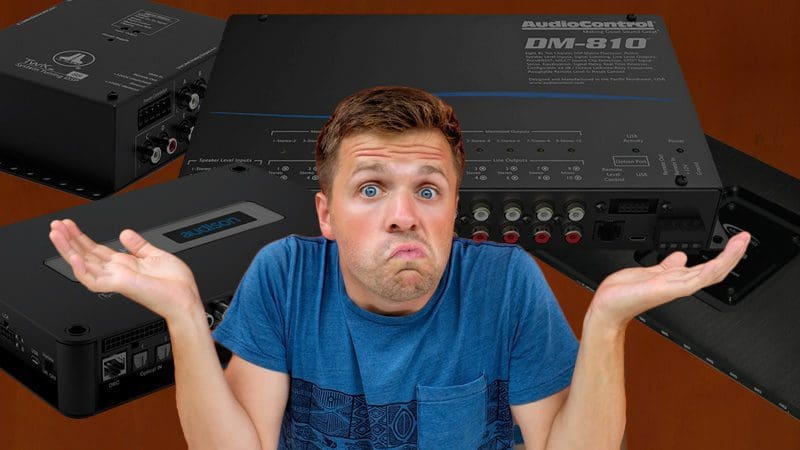 Signal processing is nothing new to car audio. In the ’80s we had stand-alone equalizers, crossovers and even phase-shifting devices — all designed to help your installer make your car audio system sound better. Lately, the focus in audio signal processing has shifted from analog to the digital domain. There are now dozens of stand-alone digital signal processors available and even more amplifiers with integrated DSP technology. Let’s take a look at why you may want to include or add a digital signal processor to your audio system.
Signal processing is nothing new to car audio. In the ’80s we had stand-alone equalizers, crossovers and even phase-shifting devices — all designed to help your installer make your car audio system sound better. Lately, the focus in audio signal processing has shifted from analog to the digital domain. There are now dozens of stand-alone digital signal processors available and even more amplifiers with integrated DSP technology. Let’s take a look at why you may want to include or add a digital signal processor to your audio system.
What Does a DSP Do?
 In a nutshell, a DSP uses a microcontroller that is designed specifically to manipulate audio signals in the digital domain. Pretty much all of the DSP devices on the market include crossovers, equalizers and signal delay features that we can use to optimize the performance of your sound system.
In a nutshell, a DSP uses a microcontroller that is designed specifically to manipulate audio signals in the digital domain. Pretty much all of the DSP devices on the market include crossovers, equalizers and signal delay features that we can use to optimize the performance of your sound system.
How Do I Know if I Need a DSP?
If you have an amplifier in your car audio system, then your stereo can benefit from a digital signal processor. All cars, trucks, SUVs, motorcycles, boats and even ATVs have reflections and resonances that change the sound we hear from the speakers. Listening to a speaker in a showroom is a very different experience from hearing that same speaker in a car or truck. Why? The acoustics of the environment are different.
Car Audio System Equalization
 At the simplest level, a DSP can be considered a glorified yet extremely precise tone control. When you combine the features of a processor with measurements from a real-time analyzer, a properly trained technician can dramatically improve the tonal balance and accuracy of your audio system. Vocals and instruments will sound more as though you are in the presence of a live performance as opposed to listening to a recording. Expert technicians can use stereo equalization to improve the staging and imaging characteristics of your sound system, helping to increase the realism of the listening experience further.
At the simplest level, a DSP can be considered a glorified yet extremely precise tone control. When you combine the features of a processor with measurements from a real-time analyzer, a properly trained technician can dramatically improve the tonal balance and accuracy of your audio system. Vocals and instruments will sound more as though you are in the presence of a live performance as opposed to listening to a recording. Expert technicians can use stereo equalization to improve the staging and imaging characteristics of your sound system, helping to increase the realism of the listening experience further.
The Importance of Accurate Crossovers
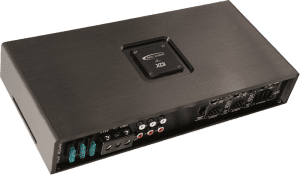
No single speaker can accurately cover the entire audible frequency range and produce adequate output to create an enjoyable listening experience. As such, car audio systems are made up of multiple speakers, each designed to operate within a specific range of frequencies. Tweeters handle high-frequency information, typically above 3kHz. Midrange drivers handle the majority of vocals and operate between 100Hz and 3kHz. Woofers and subwoofers cover low-frequency information below 100Hz. The suitability of a driver for a specific frequency range depends on its size and design.
When we design an audio system, ideally we can dedicate an amplifier channel to each speaker. In the three-way system above, we could use a five- or six-channel amplifier to power the woofer(s), midrange speakers and tweeters. The crossover functions built into a DSP handle separating the audio signal into frequency bands that are appropriate for each of those speakers.
The Benefit of Signal Delay
 Let’s continue with our three-way system example. In many systems, the tweeters are mounted at the top of the door, in the sail panel, in the dash or on the A-pillar. Midrange drivers in a system like that are typically 6.5 inches in diameter and are installed in the factory door location. Finally, woofers typically require an enclosure and are mounted in the trunk, cargo area or under the rear seat of a pickup truck. The distance between the listener and each speaker is different, as is the difference between the left and right speakers. These pathlength differences result in us hearing the closest speaker first, which makes our minds think that that is the source of the majority of what we are hearing.
Let’s continue with our three-way system example. In many systems, the tweeters are mounted at the top of the door, in the sail panel, in the dash or on the A-pillar. Midrange drivers in a system like that are typically 6.5 inches in diameter and are installed in the factory door location. Finally, woofers typically require an enclosure and are mounted in the trunk, cargo area or under the rear seat of a pickup truck. The distance between the listener and each speaker is different, as is the difference between the left and right speakers. These pathlength differences result in us hearing the closest speaker first, which makes our minds think that that is the source of the majority of what we are hearing.
The signal delay capabilities of a DSP allow the technician who is tuning the system to delay the signal going to the closest speakers, so that sound from all speakers arrives at the listening position simultaneously. When executed properly, the music in the vehicle will appear to come from a space between the speakers, rather than from the speakers themselves. If your speakers are installed in optimal locations, that virtual soundstage should appear to span the width of the windshield and place each performer and instrument accurately within this soundstage.
What Else Can a DSP Do?
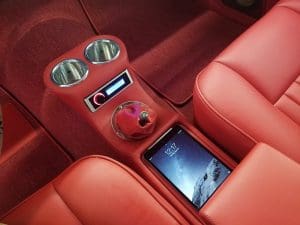
Most signal processors on the market include the ability to store multiple system configurations. If you want a tune for a single-seat listening position, then another for when you have friends in your vehicle, the tuning technician can create those. If you have a convertible, you may want a separate audio system configuration for use when the top is down.
Many processors have multiple inputs, and many include Bluetooth streaming options as an additional audio source. If you have a factory-installed source unit but want the option to stream music from a media player or smartphone, your installer can configure the system with multiple presets, each with a dedicated signal source.
Are Digital Signal Processors Expensive?
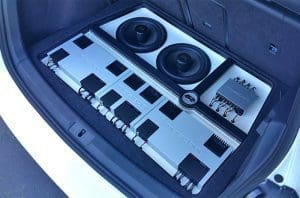 Well, yes and no. Good quality processors start around $400 plus installation and require at least an hour to configure in most vehicles. If you have a complex multi-channel system, you may need a DSP with more input and output channels and additional time to configure the system in your vehicle.
Well, yes and no. Good quality processors start around $400 plus installation and require at least an hour to configure in most vehicles. If you have a complex multi-channel system, you may need a DSP with more input and output channels and additional time to configure the system in your vehicle.
Regarding improvements to an audio system, investing $600 to $1,000 into a processor will yield performance gains that far exceed a similar investment in better speakers, amplifiers or subwoofers. If you already have a great audio system, adding a DSP and having the system tuned by a professional will improve every aspect of its performance.
Experience A Digital Signal Processor Today
If you are planning an audio system upgrade or you already have a system in your vehicle, drop by your nearest specialist mobile enhancement retailer and ask if they have a digital signal processor on display or in a demo vehicle that you can audition. Some shops will even have presets configured to demonstrate how each step of the tuning process will improve the performance of your sound system. Once you hear what a DSP can do, it’s hard not to want to buy one!
This article is written and produced by the team at www.BestCarAudio.com. Reproduction or use of any kind is prohibited without the express written permission of 1sixty8 media.
 If you are like most people, you may think that your local car stereo shop specializes in custom audio systems, speaker replacements and, if they have marketed themselves well, remote car starter installations. The reality is, many mobile enhancement retailers offer a variety of automotive enhancement services that extend well beyond audio system sales and service. Let’s have a look at some of the service options that don’t get talked about as often. (Editor’s note: Not all of these services are available at every mobile enhancement retailer.)
If you are like most people, you may think that your local car stereo shop specializes in custom audio systems, speaker replacements and, if they have marketed themselves well, remote car starter installations. The reality is, many mobile enhancement retailers offer a variety of automotive enhancement services that extend well beyond audio system sales and service. Let’s have a look at some of the service options that don’t get talked about as often. (Editor’s note: Not all of these services are available at every mobile enhancement retailer.) Many new cars and trucks come from the dealership with advanced collision avoidance technologies. The most basic is a rear-vision camera system or parking sensor system that can alert you to the presence of an object or person while maneuvering your vehicle. If your vehicle doesn’t have a backup camera or parking sensors, a system can be added quite easily.
Many new cars and trucks come from the dealership with advanced collision avoidance technologies. The most basic is a rear-vision camera system or parking sensor system that can alert you to the presence of an object or person while maneuvering your vehicle. If your vehicle doesn’t have a backup camera or parking sensors, a system can be added quite easily.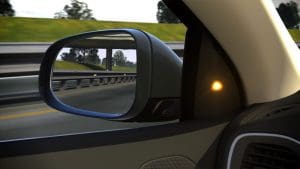 In the same vein as the parking sensors, an aftermarket blind-spot monitoring system will alert you to the presence of a vehicle or object beside or just behind yours. When an object enters this space, a small indicator will illuminate to alert you to an object in your blind spot. If you activate the turn signal, an audible warning will be produced to let you know that someone is there.
In the same vein as the parking sensors, an aftermarket blind-spot monitoring system will alert you to the presence of a vehicle or object beside or just behind yours. When an object enters this space, a small indicator will illuminate to alert you to an object in your blind spot. If you activate the turn signal, an audible warning will be produced to let you know that someone is there.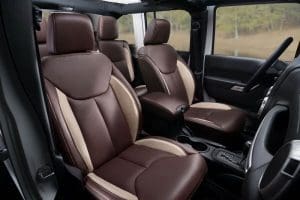 If you have an older vehicle or are interested in changing the look of your interior, your local mobile electronics specialist retailer can provide you with a complete custom interior. Companies like Katzkin, Leatherseats.com and Roadwire offer vehicle-specific seating upholstery in a variety of colors and patterns, including your choice of thread color. They can often embroider a logo into the upholstery if you wish. Many shops can also swap out the carpet in your vehicle with a new custom-molded piece in a variety of colors to complete the transformation.
If you have an older vehicle or are interested in changing the look of your interior, your local mobile electronics specialist retailer can provide you with a complete custom interior. Companies like Katzkin, Leatherseats.com and Roadwire offer vehicle-specific seating upholstery in a variety of colors and patterns, including your choice of thread color. They can often embroider a logo into the upholstery if you wish. Many shops can also swap out the carpet in your vehicle with a new custom-molded piece in a variety of colors to complete the transformation. Who better to install aftermarket
Who better to install aftermarket  A variety of new vehicles are still available without cruise control. Whether you have a classic car with a carburetor, a new vehicle with drive-by-wire throttle or something in between, aftermarket cruise control solutions are available to make your next long-distance trip a lot more comfortable.
A variety of new vehicles are still available without cruise control. Whether you have a classic car with a carburetor, a new vehicle with drive-by-wire throttle or something in between, aftermarket cruise control solutions are available to make your next long-distance trip a lot more comfortable. Are you in the market for a set of side-steps, a new toolbox for the truck bed, a new tonneau cover or an off-road-ready grille guard? Drop by your local mobile enhancement retailer. In addition to being experts at automotive electrical systems, most shops have the tools and experience required to install a variety of truck accessories.
Are you in the market for a set of side-steps, a new toolbox for the truck bed, a new tonneau cover or an off-road-ready grille guard? Drop by your local mobile enhancement retailer. In addition to being experts at automotive electrical systems, most shops have the tools and experience required to install a variety of truck accessories. If you want to know where your vehicle or fleet of vehicles is at all times, a
If you want to know where your vehicle or fleet of vehicles is at all times, a  Do you have a power window that won’t roll down, a door that doesn’t lock when you press the button on your remote, or an intermittent instrument cluster? The advanced troubleshooting experience that most mobile electronics technicians possess far exceeds that of some dealership service centers. If there is something electrical or electronic not working on your vehicle, drop by and see if they can help.
Do you have a power window that won’t roll down, a door that doesn’t lock when you press the button on your remote, or an intermittent instrument cluster? The advanced troubleshooting experience that most mobile electronics technicians possess far exceeds that of some dealership service centers. If there is something electrical or electronic not working on your vehicle, drop by and see if they can help. If you live in a state or province that allows the use of radar detectors, the team at your local car stereo shop is far and away the best choice to integrate a premium system into your vehicle. Custom installed radar detectors and laser defense systems provide early warning against police radar and can delay laser measurement devices from obtaining a speed reading.
If you live in a state or province that allows the use of radar detectors, the team at your local car stereo shop is far and away the best choice to integrate a premium system into your vehicle. Custom installed radar detectors and laser defense systems provide early warning against police radar and can delay laser measurement devices from obtaining a speed reading. Having the windows of your vehicle tinted does a lot more than simply change the style of your vehicle. Window films block almost all of the ultraviolet energy from the sun to protect the occupants from accelerated skin aging. Premium films offer infrared rejection properties that help to keep the interior of your vehicle cooler. Window tint can also make your vehicle safer. If you get into an accident, the resulting tiny pieces of glass will remain adhered to the film rather than flying across the vehicle. Finally, window tint can help to reduce crimes of opportunity. If someone can’t see the contents of your vehicle, there is less reason for them to break in.
Having the windows of your vehicle tinted does a lot more than simply change the style of your vehicle. Window films block almost all of the ultraviolet energy from the sun to protect the occupants from accelerated skin aging. Premium films offer infrared rejection properties that help to keep the interior of your vehicle cooler. Window tint can also make your vehicle safer. If you get into an accident, the resulting tiny pieces of glass will remain adhered to the film rather than flying across the vehicle. Finally, window tint can help to reduce crimes of opportunity. If someone can’t see the contents of your vehicle, there is less reason for them to break in.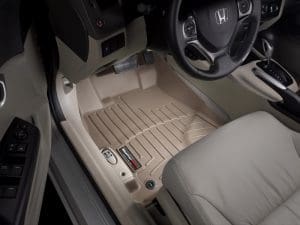 Many retailers offer automotive accessories like floor mats. One of the most popular brands in this category is WeatherTech. Their premium Floor Liner solution features a high-quality protective mat that is molded to the floor of your vehicle. The mat extends up the firewall and the center console to protect your carpet from damage, dirt and salt stains. WeatherTech also offers side window deflectors, mud flaps, bug deflectors and much more. Even if your local retailer doesn’t carry the WeatherTech brand, they should be able to source a solution to keep your vehicle looking great.
Many retailers offer automotive accessories like floor mats. One of the most popular brands in this category is WeatherTech. Their premium Floor Liner solution features a high-quality protective mat that is molded to the floor of your vehicle. The mat extends up the firewall and the center console to protect your carpet from damage, dirt and salt stains. WeatherTech also offers side window deflectors, mud flaps, bug deflectors and much more. Even if your local retailer doesn’t carry the WeatherTech brand, they should be able to source a solution to keep your vehicle looking great. Are you looking for a set of lowering springs, a computer programmer or maybe a supercharger or turbo kit? Many mobile electronics retailers have technicians available to enhance the performance of your vehicle. A bolt-on exhaust, cold-air intake, high-flow air filter or throttle body spacer can provide your vehicle with a little extra power and may improve your gas mileage at the same time.
Are you looking for a set of lowering springs, a computer programmer or maybe a supercharger or turbo kit? Many mobile electronics retailers have technicians available to enhance the performance of your vehicle. A bolt-on exhaust, cold-air intake, high-flow air filter or throttle body spacer can provide your vehicle with a little extra power and may improve your gas mileage at the same time. When it comes to creating an audio system that sounds amazing, incorporating a digital signal processor into the system gives your installer the tools required to compensate for the majority of the limitations that vehicles impose. To maximize the benefit, a digital signal processor system design needs to take the features and benefits of a processor into consideration. In this article, we are going to explain some of the key differences between a system with and without a digital signal processor.
When it comes to creating an audio system that sounds amazing, incorporating a digital signal processor into the system gives your installer the tools required to compensate for the majority of the limitations that vehicles impose. To maximize the benefit, a digital signal processor system design needs to take the features and benefits of a processor into consideration. In this article, we are going to explain some of the key differences between a system with and without a digital signal processor.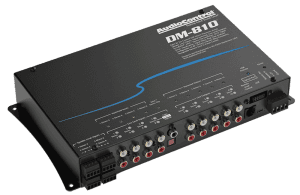 A digital signal processor, also called a DSP, is an audio processor that uses a microcomputer to make adjustments to a signal in the digital domain. In a stand-alone processor, the audio signal from the source unit is converted to a digital data stream using an analog-to-digital converter. Once in the digital domain, the processor can equalize, filter and even delay the signal. Most processors have six or more output channels to provide us with the ability to send different signals to dedicated amplifier channels. Each channel has a digital-to-analog converter that provides a conventional analog audio output.
A digital signal processor, also called a DSP, is an audio processor that uses a microcomputer to make adjustments to a signal in the digital domain. In a stand-alone processor, the audio signal from the source unit is converted to a digital data stream using an analog-to-digital converter. Once in the digital domain, the processor can equalize, filter and even delay the signal. Most processors have six or more output channels to provide us with the ability to send different signals to dedicated amplifier channels. Each channel has a digital-to-analog converter that provides a conventional analog audio output.

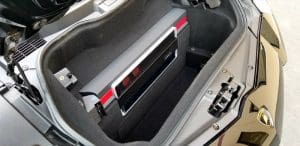
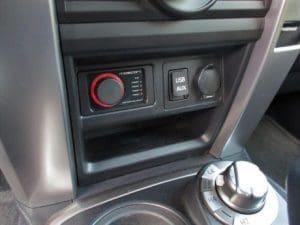
 When you think of the stereotypical
When you think of the stereotypical  The monologue introduction to “Boom Boom Pow” by will.i.am builds to a crescendo from the 45-second mark, peaking with infrasonic information from :50 to 1:03. Content during this time extends solidly down to 7 Hz. There is another drop at 2:18, and the section from 3:13 to 3:42 contains a lot of infrasonic content. If your system is up to the challenge, this track has it all: a solid conventional bass line and enough content below 20Hz to make any true basshead happy!
The monologue introduction to “Boom Boom Pow” by will.i.am builds to a crescendo from the 45-second mark, peaking with infrasonic information from :50 to 1:03. Content during this time extends solidly down to 7 Hz. There is another drop at 2:18, and the section from 3:13 to 3:42 contains a lot of infrasonic content. If your system is up to the challenge, this track has it all: a solid conventional bass line and enough content below 20Hz to make any true basshead happy!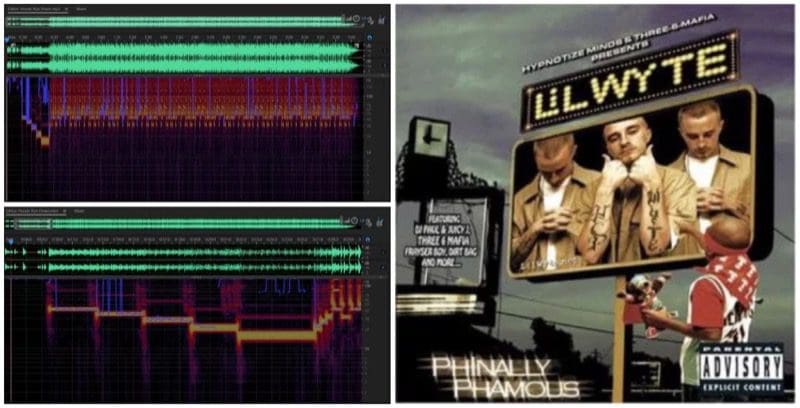 Often referred to as Bass Check, “Hoods Run Down” by Lil Wyte is a rap song that starts with an introduction and the DJ plays five sequentially lower tones. The first is centered at 41Hz, and most factory sound systems can handle this one with no problem. The second “beat” is at 35Hz, and you are going to need at least a small sub to catch this one. The third drop is centered around 27Hz and will tax premium factory systems and aftermarket systems tuned to boom rather than rumble. Now things are getting fun! The second-to-last tone is centered at 20Hz and is going to be a workout for most vented enclosures. Pay attention; speaker damage may ensue! The last beat is centered around 16Hz. You are going to need serious cone area and power to feel this one with any authority. The rest of the song continues with a standard bassline with information around 30Hz. A good workout for your stereo and a nice gentle massage for the ride home.
Often referred to as Bass Check, “Hoods Run Down” by Lil Wyte is a rap song that starts with an introduction and the DJ plays five sequentially lower tones. The first is centered at 41Hz, and most factory sound systems can handle this one with no problem. The second “beat” is at 35Hz, and you are going to need at least a small sub to catch this one. The third drop is centered around 27Hz and will tax premium factory systems and aftermarket systems tuned to boom rather than rumble. Now things are getting fun! The second-to-last tone is centered at 20Hz and is going to be a workout for most vented enclosures. Pay attention; speaker damage may ensue! The last beat is centered around 16Hz. You are going to need serious cone area and power to feel this one with any authority. The rest of the song continues with a standard bassline with information around 30Hz. A good workout for your stereo and a nice gentle massage for the ride home.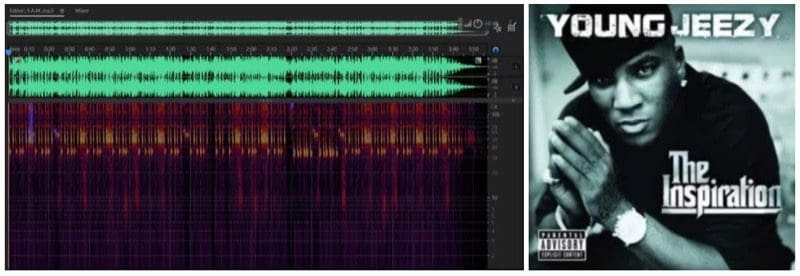 Another classic rap track, “3 A.M.” features a steady bass line that extends down to around 30Hz, giving almost any sound system a chance to sound great. Interspersed randomly through the track are bass drops down to the single digits. There is lots of 9Hz content at the :57 and 2:01 marks. These don’t last long, but they are reasonably loud. You’ll hear 10-cycle beats at 0:37, 1:03, 1:54, 2:45, 3:11 and 3:37. There is lots of 50Hz content during these drops, so it might be hard to pick them out, but they are there.
Another classic rap track, “3 A.M.” features a steady bass line that extends down to around 30Hz, giving almost any sound system a chance to sound great. Interspersed randomly through the track are bass drops down to the single digits. There is lots of 9Hz content at the :57 and 2:01 marks. These don’t last long, but they are reasonably loud. You’ll hear 10-cycle beats at 0:37, 1:03, 1:54, 2:45, 3:11 and 3:37. There is lots of 50Hz content during these drops, so it might be hard to pick them out, but they are there.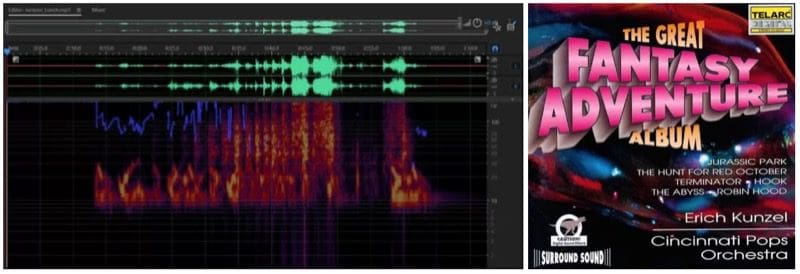 This is more of a demo track than a song. Included on The Great Fantasy Adventure Album with main title themes from movies like Terminator 2, Clash of the Titans, Total Recall and The Abyss, “Jurassic Lunch” is a short 1:11 track at the end of the album. The track starts with birds chirping in the jungle. At the 13-second mark, a series of pulsations centered at 12Hz and 24Hz start. These continue to the 29-second mark, where harmonics are included that provide content above 30 cycles. It’s only then that you realize you are hearing the footsteps of the Tyrannosaurus rex stomping through the Jungle. Around the 39-second mark, you start to hear tree branches breaking with each step, and then at the 45-second mark, the roar of the Rex overpowers the track as he devours his prey. Of course, Kunzel included lots of bone-cracking and crunching around the 51-second mark. The Rex savors his meal from the 51- to 56-second mark, where he rewards himself with a giant burp that peaks with information down to 10Hz at the 59-second mark. This track serves as an awesome demonstration of a true subwoofer system.
This is more of a demo track than a song. Included on The Great Fantasy Adventure Album with main title themes from movies like Terminator 2, Clash of the Titans, Total Recall and The Abyss, “Jurassic Lunch” is a short 1:11 track at the end of the album. The track starts with birds chirping in the jungle. At the 13-second mark, a series of pulsations centered at 12Hz and 24Hz start. These continue to the 29-second mark, where harmonics are included that provide content above 30 cycles. It’s only then that you realize you are hearing the footsteps of the Tyrannosaurus rex stomping through the Jungle. Around the 39-second mark, you start to hear tree branches breaking with each step, and then at the 45-second mark, the roar of the Rex overpowers the track as he devours his prey. Of course, Kunzel included lots of bone-cracking and crunching around the 51-second mark. The Rex savors his meal from the 51- to 56-second mark, where he rewards himself with a giant burp that peaks with information down to 10Hz at the 59-second mark. This track serves as an awesome demonstration of a true subwoofer system.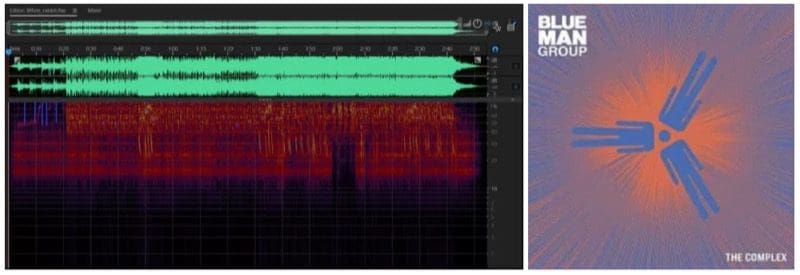 This remake of “White Rabbit” by Jefferson Airplane features the required tuned PVC tubing percussion that has made Blue Man Group so unique. Though this track doesn’t share the intense infrasonic peaks of our other suggestions, it maintains an impressive level of 15-cycle content throughout the almost three-minute-long track. There is very evenly dispersed mid-bass energy in this track as well — a great challenge for your door speakers.
This remake of “White Rabbit” by Jefferson Airplane features the required tuned PVC tubing percussion that has made Blue Man Group so unique. Though this track doesn’t share the intense infrasonic peaks of our other suggestions, it maintains an impressive level of 15-cycle content throughout the almost three-minute-long track. There is very evenly dispersed mid-bass energy in this track as well — a great challenge for your door speakers.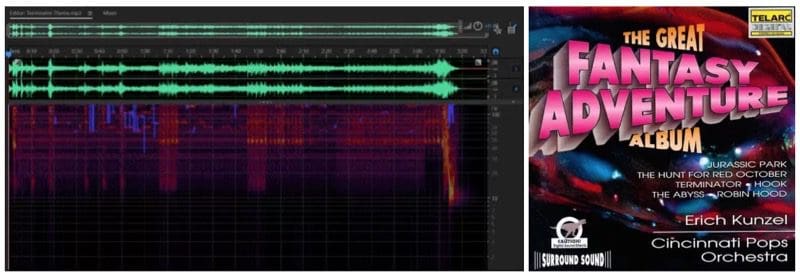 Another fun track from The Great Fantasy Adventure Album is the Terminator theme. This haunting track is full of special effects and mechanical sounds that remind listeners of the end scene of Terminator 2 as the machine slowly lowers himself into the mass of molten steel in the refinery. While most of the percussion comes from kettle drums in the 47-48 Hz range, the closing of the track features an explosion that starts at the 3:11 mark and peaks with 11Hz information from 3:14 to 3:16. A fitting ending to a great track.
Another fun track from The Great Fantasy Adventure Album is the Terminator theme. This haunting track is full of special effects and mechanical sounds that remind listeners of the end scene of Terminator 2 as the machine slowly lowers himself into the mass of molten steel in the refinery. While most of the percussion comes from kettle drums in the 47-48 Hz range, the closing of the track features an explosion that starts at the 3:11 mark and peaks with 11Hz information from 3:14 to 3:16. A fitting ending to a great track.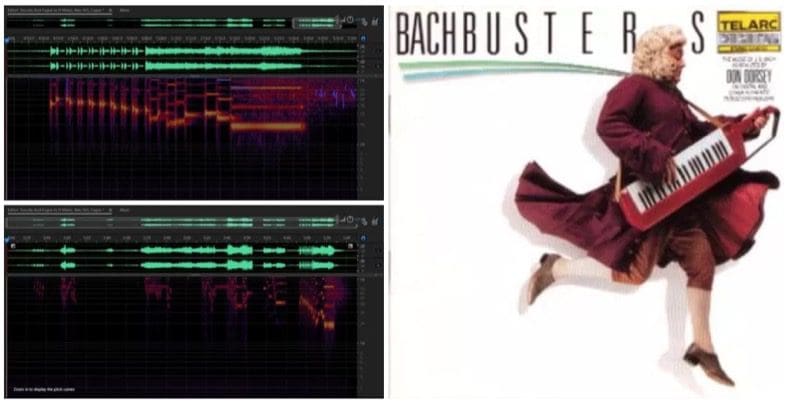 This track goes back, waaaay back! Scholars think that Bach wrote this classic piece of organ music between 1704 and 1750 (when he died). Even those who don’t listen to classical music recognize this track. Don Dorsey released Bachbusters, a synthesizer-based take on some of Johann Sebastian Bach’s greatest pieces, in 1985. The album took first place on the Billboard classical music chart and has been popular with car audio enthusiasts ever since.
This track goes back, waaaay back! Scholars think that Bach wrote this classic piece of organ music between 1704 and 1750 (when he died). Even those who don’t listen to classical music recognize this track. Don Dorsey released Bachbusters, a synthesizer-based take on some of Johann Sebastian Bach’s greatest pieces, in 1985. The album took first place on the Billboard classical music chart and has been popular with car audio enthusiasts ever since.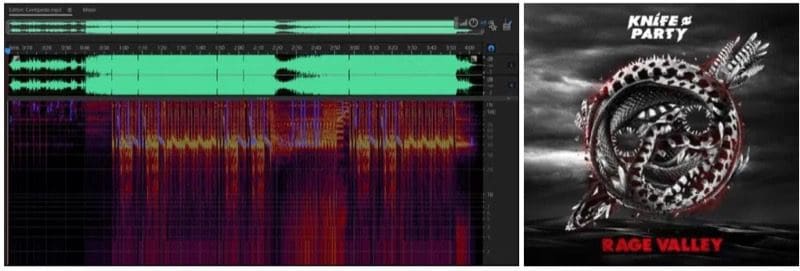 There had to be some dubstep in this list somewhere, right? “Centipede” is a somewhat creepy track that is full of fun bass. While the focus of the bass line is around 40Hz, the track contains content with good output levels down to the 10Hz range. While we doubt most clubs could reproduce this infrasonic information with serious output levels, the sensation of listening to this in a well-designed mobile audio system would be fantastic. It’s also really loud: The VU meters remain pinned at the 0dB mark for the majority of the track.
There had to be some dubstep in this list somewhere, right? “Centipede” is a somewhat creepy track that is full of fun bass. While the focus of the bass line is around 40Hz, the track contains content with good output levels down to the 10Hz range. While we doubt most clubs could reproduce this infrasonic information with serious output levels, the sensation of listening to this in a well-designed mobile audio system would be fantastic. It’s also really loud: The VU meters remain pinned at the 0dB mark for the majority of the track.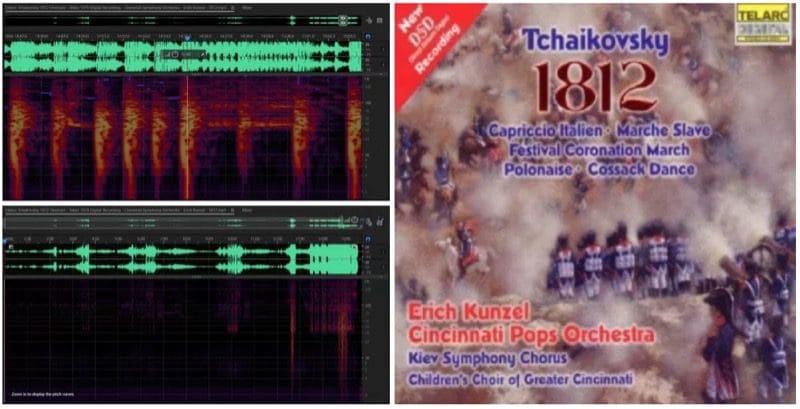 Another all-time-classic classical recording is Tchaikovsky’s 1812 Overture. This recording is known for its jaw-dropping cannon blasts at the end. When played back on a vinyl record, all but the very best turntable configurations will result in the needle jumping out of the track as the cannons go off. The first five cannon blasts appear at 12:36 into the track. The second and most impressive group begins at 14:41, with the blast at 14:55 containing low-frequency energy that extends down to nearly DC levels. Call it one to two Hertz if you want – it makes no difference.
Another all-time-classic classical recording is Tchaikovsky’s 1812 Overture. This recording is known for its jaw-dropping cannon blasts at the end. When played back on a vinyl record, all but the very best turntable configurations will result in the needle jumping out of the track as the cannons go off. The first five cannon blasts appear at 12:36 into the track. The second and most impressive group begins at 14:41, with the blast at 14:55 containing low-frequency energy that extends down to nearly DC levels. Call it one to two Hertz if you want – it makes no difference. “Purple Lamborghini” won a Grammy Award for Best Song Written for Visual Media. This rap track contains a bass line that is centered around 38Hz for the majority of the track. But the fun doesn’t stop there: Four times in the track, the bass sweeps from 50 down to 22Hz with impressive output. The video features Rick Ross, Skrillex and none other than Jared Leto in full Joker garb.
“Purple Lamborghini” won a Grammy Award for Best Song Written for Visual Media. This rap track contains a bass line that is centered around 38Hz for the majority of the track. But the fun doesn’t stop there: Four times in the track, the bass sweeps from 50 down to 22Hz with impressive output. The video features Rick Ross, Skrillex and none other than Jared Leto in full Joker garb. “Put On” makes our list with what we’ll call an honorable mention. The track doesn’t dig hard into the infrasonic region but contains four drops that repeat through the entire track. The first is up at 55Hz and is classic rap music bass. The second is at 44Hz and the third is at 36Hz, giving your body a nice massage. The last is centered around 27Hz and will give your subwoofers a good workout. We included this track because the 27Hz bass line appears no less than 22 times in this 5:21-second track.
“Put On” makes our list with what we’ll call an honorable mention. The track doesn’t dig hard into the infrasonic region but contains four drops that repeat through the entire track. The first is up at 55Hz and is classic rap music bass. The second is at 44Hz and the third is at 36Hz, giving your body a nice massage. The last is centered around 27Hz and will give your subwoofers a good workout. We included this track because the 27Hz bass line appears no less than 22 times in this 5:21-second track. The second of our three Honorable Mention tracks is “This Means War” by Avenged Sevenfold. This rock track opens with well-recorded percussion and guitar. At the 25-second mark, there is a rumble of thunder with great content down to 20 Hz that slowly fades to the 30-second mark. The remainder of the track only gets down to about 40Hz, but the kick drum is well-recorded and the entire track is well worth listening to.
The second of our three Honorable Mention tracks is “This Means War” by Avenged Sevenfold. This rock track opens with well-recorded percussion and guitar. At the 25-second mark, there is a rumble of thunder with great content down to 20 Hz that slowly fades to the 30-second mark. The remainder of the track only gets down to about 40Hz, but the kick drum is well-recorded and the entire track is well worth listening to. Another honorable mention is Lorde’s “Supercut.” Though the main bass line remains focused between 40 and 60 Hz for the majority of the track, the section of the song from 2:34 to 3:05 has a surprising amount of information that extends down to 10 cycles at a moderate level.
Another honorable mention is Lorde’s “Supercut.” Though the main bass line remains focused between 40 and 60 Hz for the majority of the track, the section of the song from 2:34 to 3:05 has a surprising amount of information that extends down to 10 cycles at a moderate level. Winning our “what the heck is that doing there?” award is “Supermarket Flowers” by Ed Sheeran. This track features Sheeran accompanied by a piano for the majority of the track. At the 2:08 mark, a synthesizer comes in to add some a gentle bass line to the track. The lowest notes are 28Hz at the 2:32 mark. While not the infrasonic content we were searching for, this remains a nice surprise in what would be described as a nice song.
Winning our “what the heck is that doing there?” award is “Supermarket Flowers” by Ed Sheeran. This track features Sheeran accompanied by a piano for the majority of the track. At the 2:08 mark, a synthesizer comes in to add some a gentle bass line to the track. The lowest notes are 28Hz at the 2:32 mark. While not the infrasonic content we were searching for, this remains a nice surprise in what would be described as a nice song.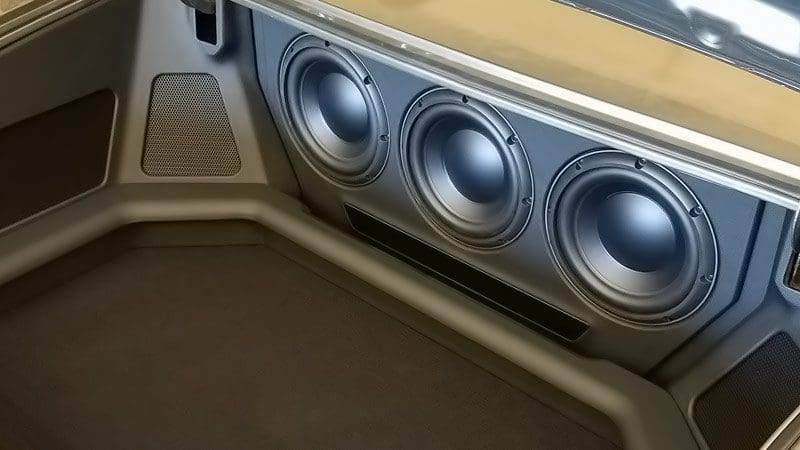 Beyond the features and design of a subwoofer, no single factor affects the performance of a subwoofer system more than
Beyond the features and design of a subwoofer, no single factor affects the performance of a subwoofer system more than 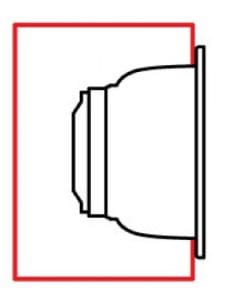
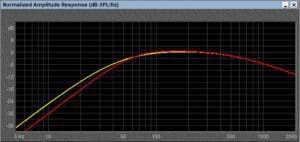 As you can see, above 60Hz, the smaller enclosure is a little bit louder but remains within a decibel or two. Below 50Hz is where things start to vary more. The larger enclosure is 2.15 dB louder at 35Hz and 3.35 dB louder at 25 Hz. While it might not appear dramatic, 3dB is the equivalent of having twice as much power driving the subwoofer. However, this increase in efficiency comes with no thermal power handling penalty.
As you can see, above 60Hz, the smaller enclosure is a little bit louder but remains within a decibel or two. Below 50Hz is where things start to vary more. The larger enclosure is 2.15 dB louder at 35Hz and 3.35 dB louder at 25 Hz. While it might not appear dramatic, 3dB is the equivalent of having twice as much power driving the subwoofer. However, this increase in efficiency comes with no thermal power handling penalty.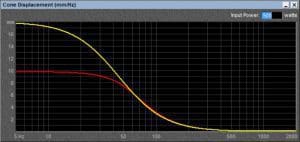 Once again, above 60Hz, there is minimal difference in the excursion between the two drivers. Below that, the larger volume of air in the big enclosure has less effect on the stiffness of the subwoofer system. The result is the subwoofer moves farther for each watt of power. If you compare the excursion graph to the frequency response graph, the efficiency levels are directly correlated.
Once again, above 60Hz, there is minimal difference in the excursion between the two drivers. Below that, the larger volume of air in the big enclosure has less effect on the stiffness of the subwoofer system. The result is the subwoofer moves farther for each watt of power. If you compare the excursion graph to the frequency response graph, the efficiency levels are directly correlated. The second popular option for a subwoofer enclosure is a
The second popular option for a subwoofer enclosure is a  Now, while most vented enclosures are larger than their sealed brethren, the benefit is often an increase in output that is potentially more than having two subs in a sealed design. In fact, this vented design is louder from 20 to 60Hz than three identical subs in an enclosure that is 50% larger (1.8 cubic feet).
Now, while most vented enclosures are larger than their sealed brethren, the benefit is often an increase in output that is potentially more than having two subs in a sealed design. In fact, this vented design is louder from 20 to 60Hz than three identical subs in an enclosure that is 50% larger (1.8 cubic feet).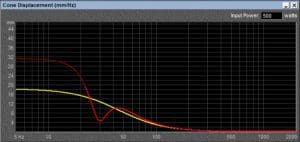 This reduction in cone excursion increases physical power handling and also reduces distortion – as long as you have designed and constructed the vent properly. Vents need to have a large enough area so that air velocity in the vent is kept to a minimum. The mouth of the vent also needs to have a large radius
This reduction in cone excursion increases physical power handling and also reduces distortion – as long as you have designed and constructed the vent properly. Vents need to have a large enough area so that air velocity in the vent is kept to a minimum. The mouth of the vent also needs to have a large radius Bandpass enclosures are called that because they not only act as a high-pass filter but as a low-pass filter as well. A typical bandpass enclosure features two chambers. The woofer is mounted between these chambers. In a single-tuned enclosure (often referred to as a fourth-order bandpass or single- reflex bandpass), one of the chambers includes a vent from which all the sound is created. A benefit of this design is the ability to feed that vent through an opening in a rear parcel shelf or similar to ensure coupling with the interior of the vehicle.
Bandpass enclosures are called that because they not only act as a high-pass filter but as a low-pass filter as well. A typical bandpass enclosure features two chambers. The woofer is mounted between these chambers. In a single-tuned enclosure (often referred to as a fourth-order bandpass or single- reflex bandpass), one of the chambers includes a vent from which all the sound is created. A benefit of this design is the ability to feed that vent through an opening in a rear parcel shelf or similar to ensure coupling with the interior of the vehicle.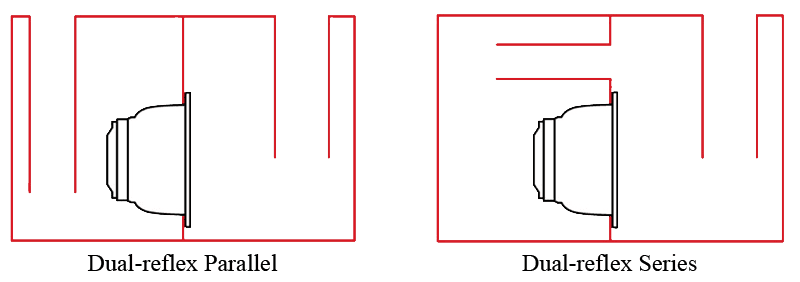 The second bandpass enclosure design is a Double-tuned design where both the front and rear chambers are vented. In a Series-tuned bandpass enclosure, the large rear chamber vent feeds into the front chamber. In a parallel-tuned design, the vents from each chamber feed directly into the listening area. Double-tuned bandpass designs are often referred to a sixth-order or dual-reflex designs.
The second bandpass enclosure design is a Double-tuned design where both the front and rear chambers are vented. In a Series-tuned bandpass enclosure, the large rear chamber vent feeds into the front chamber. In a parallel-tuned design, the vents from each chamber feed directly into the listening area. Double-tuned bandpass designs are often referred to a sixth-order or dual-reflex designs. A quick note on “basic” subwoofer systems. Over the years, we’ve seen a LOT of retailers offer “bass packages” that include a sub, amplifier, enclosure and often a wiring kit. In the majority of these packages, the retailer has paired an inexpensive sub with an inexpensive amp and a sealed subwoofer enclosure to minimize the total cost of the system. When you are limited in
A quick note on “basic” subwoofer systems. Over the years, we’ve seen a LOT of retailers offer “bass packages” that include a sub, amplifier, enclosure and often a wiring kit. In the majority of these packages, the retailer has paired an inexpensive sub with an inexpensive amp and a sealed subwoofer enclosure to minimize the total cost of the system. When you are limited in